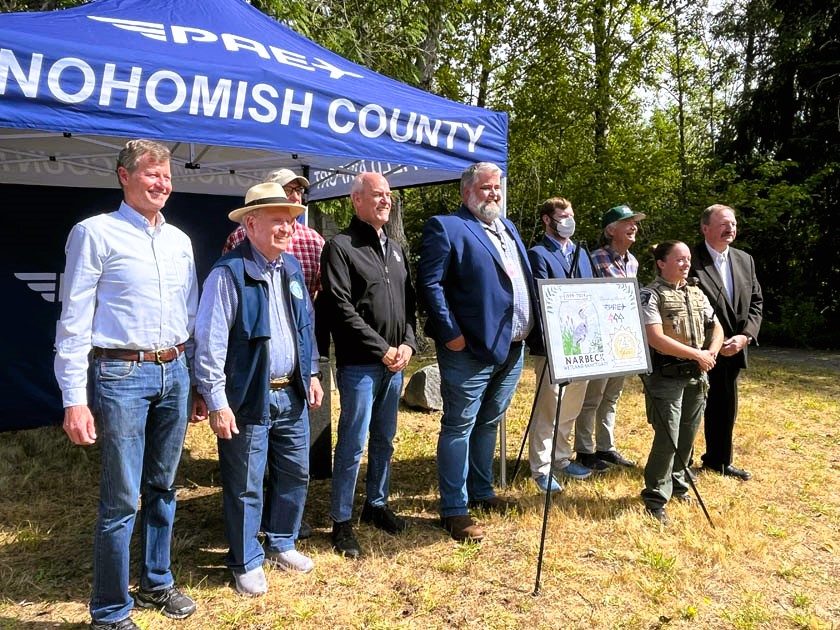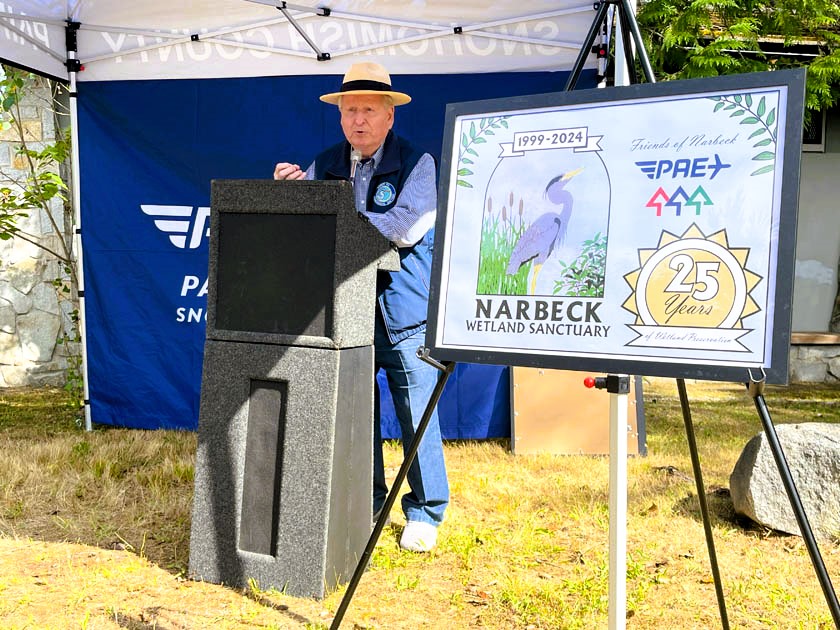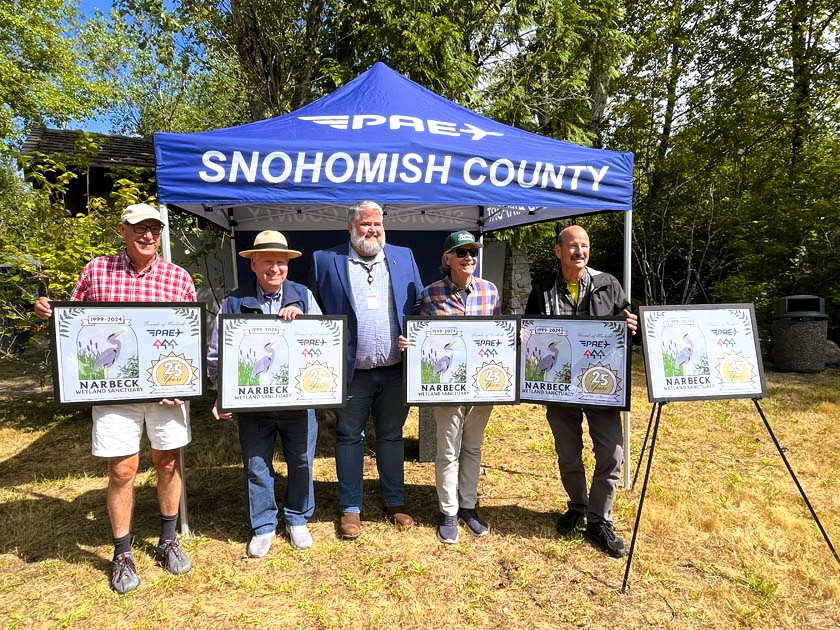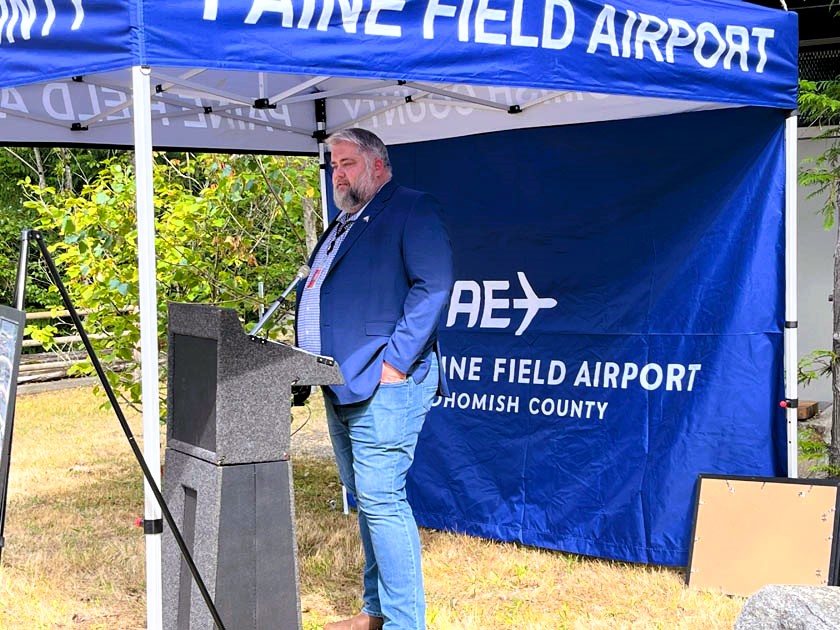EVERETT—Snohomish County Executive Dave Somers joined Washington State Representative Rick Larsen (WA-02), Paine Field Airport Director Joshua Marcy, local nonprofit Friends of Narbeck and members of the original Narbeck planning team on Wednesday, July 31, to celebrate the 25th anniversary of the Narbeck Wetland Sanctuary wetlands mitigation bank, the first ever in Washington State.

Mitigation banking is when a new wetland is created in advance of adversely affecting current wetlands. Narbeck Wetland Sanctuary, located at 6900 Seaway Boulevard in Everett, is a 42.76-acre park accessible for passive recreational use with trails, interpretive signs, viewpoints, picnic tables, and restrooms.
There are also two walking trails, a small loop trail, and a half mile interpretative trail around the perimeter with educational signs and self-guided tours. During the school year, Park Rangers can even be scheduled to give students educational demonstrations on the park, its function as a wetland mitigation site, and the various wildlife that call it home.
Since opening in 1999, the Narbeck Wetland Sanctuary has since become the model for wetland mitigation sites statewide. Today there are about 20 wetland mitigation banks in Washington including the Skykomish Habitat Bank and the Snohomish Basin Bank both located in Snohomish County.

“We need to think of wetlands as critical infrastructure here in the Northwest,” said Representative Larsen. “When we do that we learn that our infrastructure can have major benefits to the economy and the environment.”
Representative Larsen served with Snohomish County Executive Dave Somers on the County council when the council approved the project back in in the late 90’s.
Executive Somers said Wednesday that the project benefits the local economy as well as the environment as a whole. He thanked the several community partners that made the project possible and looks forward to celebrating its 50th anniversary in 2049.
According to Bill Lewallen, Friends of Narbeck member and former Paine Field’s Director of Land Development when the project kickstarted, the driving mantra of the project was “how we do things is just as important as what we do.”

They did this, he said, by casting a vision that was big enough so they could invite regulatory partners to take a risk that was worth investing in the project. Secondly, the Friends of Narbeck surrounded themselves with quality people who bought into that vision.
Lewallen also belongs to the Friends of Harbor Hill nonprofit, which he and his fellow Gig Harbor neighbors created after he shared the inspiration and vision of what could be based on his work to create Narbeck, Kirstin Banfield, Public Information Officer for Paine Field, told the Lynnwood Times.
In its first six years Friends of Harbor Hill raised $750,000 in donations. Last summer the nonprofit completed its first phase of construction with that storm retention bond to create the Harbor Hill Environmental Sanctuary—a 25-acre environmental park that’s open to the public in Gig Harbor. The second phase of that project begins next summer adding environmental education signs and new plants.

“That’s part of your legacy and I’m honored to be in the hunt with you,” said Lewallen. “If you worked in creating or supporting Narbeck you helped make that happen. Lives are going to be changed in all sorts of ways that you can’t even imagine.”
One example of “changing lives” LeWallen gave was during an event called the “Sanctuary Stroll” that is dedicated to mobility challenged individuals. It was the first time these individuals had ever had the opportunity to stroll the 25-acre environmental park since a 15-foot-wide paved trail was added during the first phase of the construction project. The experience LeWallen shared, was a mixture of tears, smiles, and high-fives.
When the Narbeck Wetland Sanctuary was dedicated and opened on July 31, 1999, as a passive recreation and environmental education public park, the idea was innovative.

Before Snohomish County, which owns and operates Paine Field Airport, could impact several small wetlands on airport property for runway safety projects, it needed to create new wetlands. The 50-acre Narbeck Wetland site was one of the resulting wetlands the Airport enhanced and built.
In April of 2008, regulatory agencies determined the Narbeck Wetland Mitigation Bank and the Swanson Wetland Mitigation Bank fully met all environmental performance standards and the mitigation credits were made available for use.
A month later, Snohomish County received top honors from the Washington State Department of Ecology for its approved wetland mitigation banks, the first in the state to receive full local, state and federal accreditation.
The Friends of Narbeck Wetland Sanctuary has protected the conservation values of Narbeck since it opened.

“There’s always somebody in here making sure that this asset that we stays an asset that we have and we manage it effectively,” said Paine Field Airport Director Joshua Marcy.
The Narbeck Wildlife Sanctuary has received numerous federal, state and regional environmental awards, and volunteers from Friends of Narbeck conduct several environmental educational group tours annually. The park hosts approximately 300 business and residential users daily, the county said.
Author: Kienan Briscoe









